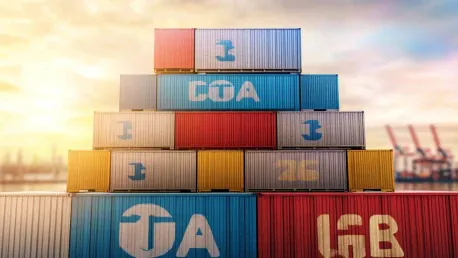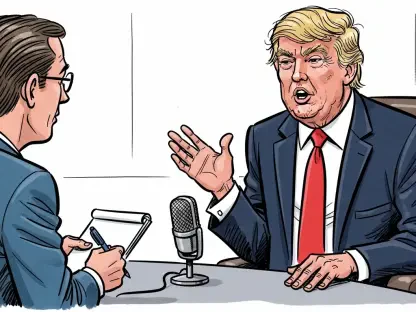The announcement of President Donald Trump’s extensive and rigorous tariff policies in early 2025 has created shockwaves throughout global trade markets. Aimed at narrowing the United States trade deficit while fostering domestic manufacturing, these tariffs are among the most sweeping and significant implemented during Trump’s time in office. This article delves into the motivations behind these tariffs, the anticipated economic benefits touted by the administration, the swift and critical reactions from global trading partners, and the potential far-reaching consequences for both the U.S. economy and its international trade relationships.
The Scope and Nature of the Tariffs
President Trump has put into effect one of the most significant shifts in U.S. trade policy in recent memory. Highlighted by a 25% tariff on nearly all imported cars and essential auto parts initiated on April 3, 2025, these measures reflect his administration’s aggressive stance on reducing dependency on foreign vehicles and promoting U.S. manufacturing. Furthermore, the tariffs on steel and aluminum, which were increased to 25% in March, and a hefty 20% tariff on Chinese imports implemented in early March, have further escalated the stakes in international trade.
These measures encompass a broader application, extending to an almost exhaustive range of products from nearly all countries. By laying the groundwork for potential tariffs on critical sectors like lumber and pharmaceuticals, Trump has sent a clear signal of his determination to reshape the global trade landscape. This broad sweeping approach underscores his commitment to addressing trade imbalances while prioritizing American business interests, even at the risk of economic retaliation from trading partners.
Immediate Reactions from Trading Partners
Global trading partners have responded swiftly and decisively to President Trump’s tariff policies. Canada and Mexico, long-standing trade allies under the United States-Mexico-Canada Agreement (USMCA), find themselves in complex negotiations to secure exemptions from the new tariffs. Canada’s government, led by Prime Minister Mark Carney, has not hesitated to impose retaliatory tariffs amounting to 25% on $30 billion worth of U.S. goods. This response highlights the pressures faced by regional allies in maintaining balanced trade relations while mitigating economic disruptions.
The European Union has similarly signaled its discontent, preparing countermeasures aimed at $28 billion worth of U.S. exports. Though the EU remains open to negotiations, the clear message from Brussels is one of readiness to protect European economic interests. Meanwhile, China has vehemently criticized the new tariffs, implementing its own retaliatory tariffs on U.S. agricultural products and suspending certain imports. The response from Beijing underscores the tension and fragility of U.S.-China trade relations, which are already burdened with longstanding disagreements.
Potential Economic Consequences for the U.S.
Economists have issued cautionary statements regarding the potential adverse outcomes of Trump’s broad tariff policies. One immediate concern is the increased cost of goods for U.S. businesses and consumers alike. As tariffs drive up the prices of imported components and products, these increased costs are likely to be passed down the supply chain, resulting in higher prices for everyday goods and services. This scenario has raised alarms about its potential to exacerbate inflation, disproportionately affecting lower-income households.
The automotive industry is a particular focal point of concern. The newly imposed tariffs are expected to substantially increase production costs for both U.S. manufactured and imported vehicles. This could lead to operational challenges and potential layoffs within the industry, creating a ripple effect that extends to suppliers and related businesses. Companies may find themselves squeezed by higher input costs and stagnating demand, resulting in production cutbacks and reduced investment in growth initiatives.
Domestic Industrial Impact
Domestically, the impact of President Trump’s tariff policies presents a mixed picture. On one hand, sectors like steel manufacturing benefit from the protectionist measures, which create an incentive for increased domestic production. This has the potential to bolster job growth within the industry, as facilities ramp up operations to meet demands that were previously fulfilled by imports. The sense of security provided by the tariffs can foster investment and expansion, creating a favorable environment for local manufacturers.
Conversely, industries heavily reliant on imported components may face significant adversity. For these sectors, the challenges of rising costs and limited access to essential materials create profound operational difficulties. Reduced production capacity and layoffs in affected industries are realistic outcomes, as businesses scramble to navigate the new economic landscape. The uncertainty generated by the tariffs can deter investment and disrupt existing supply chains, leading to long-term economic consequences that may offset short-term gains in specific manufacturing sectors.
Global Trade Dynamics and Tensions
Trump’s tariff policies have significantly heightened trade tensions, leading to a reshaping of global trade dynamics. The unpredictable nature of these tariffs has introduced a level of economic uncertainty and market volatility that is felt both domestically and internationally. Retaliatory measures from trade partners further complicate the economic environment, as nations implement their own tariffs in response, creating a tit-for-tat scenario that could result in a prolonged trade conflict.
Such sustained trade disputes have the potential to slow global economic growth. Economic relations strain under the pressure of continuous rounds of tariffs and counter-tariffs, and businesses face uncertainty over future trade conditions. This environment can stifle international investment and hinder the flow of goods and services across borders, leading to inefficiencies and a potential contraction in global trade volumes. The consequences of these tensions are far-reaching, affecting not only current economic conditions but also the future of international economic cooperation.
Legislative and Public Opposition
Within the United States, there is notable legislative and public opposition to President Trump’s tariff strategy. The U.S. Senate’s bipartisan vote against tariffs on Canadian imports is a significant instance of political resistance, highlighting concerns across party lines about the broader economic implications of such policies. Senators have voiced apprehensions regarding the impact on American consumers, businesses, and the overall economy, reflecting the contentious nature of the tariffs.
Public opinion is equally divided, with supporters advocating for the perceived benefits of reducing trade deficits and protecting domestic industries. Critics, on the other hand, warn of the financial hardships that could ensue, including increased costs for everyday goods, disrupted supply chains, and potential job losses in vulnerable sectors. The tariffs’ divisive nature fuels a broad spectrum of perspectives, emphasizing the complexity and far-reaching ramifications of Trump’s trade policies.
Future Developments and Projections
The administration believes these tariffs will give a competitive edge to American manufacturers by making imported goods more expensive, thereby encouraging consumers to buy American-made products. However, many global trading partners have criticized the tariffs, arguing they will disrupt international trade and lead to increased prices for consumers worldwide.
In conclusion, while President Trump’s tariffs aim to strengthen the U.S. economy and promote domestic production, they have already sparked significant controversy and concern among international trade partners. The true impact of these tariffs on the U.S. economy and global trade remains to be seen, as the world waits to see how these policies will unfold over time. The ensuing trade dynamics will be closely monitored by economists, policymakers, and businesses around the globe.









